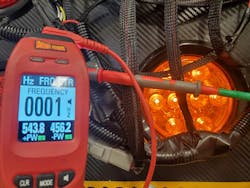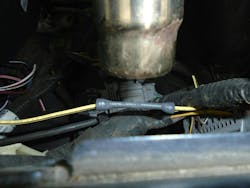Just because something is basic doesn't mean it's simple or unimportant. For example, "basic" electrical connector maintenance is one of the largest critical factors in ensuring the driver’s safety and the truck's uptime. After all, if wiring connectors are not properly maintained, vibrations, road salts, and more can cause dim or flickering vehicle lights and other intermittent electrical issues.
At best, these issues can cause headaches for technicians, and at worst cause an inspector to put a vehicle out of service. Additionally, these connections are also costly to replace, so maintenance is the best way to keep spending down.
To avoid these problems, first you need to have a good understanding of the main electrical connections you'll be working with:
- The 7-way connections: This vital system links all electrical systems from the truck to the trailer. If faulty, your truck can suffer significant damage, a trailer can disconnect, and a compromised load can cause a serious accident. Ensuring a quality 7-way connection between the truck and trailer is vital to a solid rig that won’t leave you in the lurch.
- Lighting system connections: When connectors on the lighting system fail, the brake lights stop working, resulting in heavy fines and the possible suspension of your commercial license.
- Battery and charging connections: Layover points can become a nightmare for truckers when their vehicles don’t start because of damaged batteries and charging connectors.
Core tips for well-maintained wiring connectors
You should regularly inspect all wiring connectors to ensure your rig functions with optimal electrical efficiency. Even sealed connectors can malfunction or fail, especially since the road is far from smooth and can damage delicate parts. So, to begin the electrical maintenance process, follow these steps:
- Conduct wiring connector inspection: Inspect the wiring connectors of all three major wiring systems. Ensure each trucker has their own inspection toolkit containing the necessary screwdrivers, voltage meter, insulating tape, and replacement parts.
- Clean connectors and apply protection: Use a plug-and-socket brush to clean all visible connectors. Coat them with dielectric grease to prevent corrosion from damaging the metal prongs.
- Avoid wire damage when testing voltage: If a technician tests for a malfunction, don’t puncture the insulating wires or connector case.
Eliminating corrosion from wiring connectors
Corrosion is a common cause of damage to wiring connectors, especially on rigs that run in colder parts of the U.S., where road management salts the roads during icy weather. Salt hastens the oxidation of metal, resulting in more rust. Older types of wire connectors are less robust and may often crack, speeding up the corrosion of the metal components. Therefore, checking and sealing these connectors with insulation tape and dielectric grease is essential.
Corrosion-resistant materials like nylon straps are ideal to wrap around exposed connectors and other metal parts. Every bit of protection helps.
Nylon straps and sleeves can also protect rusted wiring, which often happens when wires bend or get clamped in the truck chassis. Secure the wiring connector to the wiring harness, or vibrations may damage the wires as they enter the connector, leading to oxidation and rust.
Read more: Expert tips to speed up and streamline electrical repairs
There are several ways to clean off corrosion from trialer connectors, but here's one from YouTube channel 4DIYers that explains the process in under a minute:
Maintaining unsealed wiring connectors
Older rigs often have unsealed wiring connectors which require frequent maintenance. Inspections and repairs should include using connector sealing plugs to occupy any female plug points that are not in use. When debris accumulates in these openings, it can lead to malfunctions and electrical shorts. Any organic material that collects in these connectors can also increase the risk of corrosion.
When trailers are stored between uses, sealing the connections and preventing dirt from contaminating the pins and male-to-female plugs is essential.
Inspections before hitching a trailer should include a careful examination of all seven pins’ connections as well as cleaning the male-female connection. Ensure you connect all seven pins correctly using the appropriate wiring combinations, which ensures no crossed connections or faulty lights.
- White: Earth wire
- Blue: Electric brakes
- Green: Right turn indicators and brake light
- Yellow: Left turn indicators and brake light
- Brown: Tail lights and running lights
- Red: Reverse lights
- Black: Backup lights
Seal any exposed connectors with heat shrink tubing or insulating tape, even if it’s a single trip with that particular trailer.
Points to note for inspections
More trucks are now using LED lights for their fittings. One benefit is their extended life span, so they may not need as frequent inspection and repair, but the weak spot remains the connectors. Have your drivers visually inspect these and run a self-diagnostic scan before repairing faulty connections as necessary.
It’s also vital to perform a full wiring inspection after the vehicle sat in or traveled through bad conditions. If there’s water where it shouldn’t be or the wires get slightly dislodged, it can lead to easily preventable damage. To maintain the connections, always double-check the connections for LED lights — even if they seem in good condition — and do a check-in with the truck’s internals after traversing unideal roads.
The last connector
Vibrations, friction, and impact from road debris can harm a rig’s electrical systems, so secure your Classes 1-8 commercial truck’s wiring connectors from road damage. Regular maintenance, visual inspection, and a careful eye on the vehicle’s systems can help you avoid serious downtime from wire connector failure.
About the Author

Jack Shaw
Jack Shaw is a seasoned writer and editor with a robust background in the automotive manufacturing and engineering sectors. Currently serving as the automotive editor of Modded, he focus on researching and writing articles that delve into the latest trends and technologies shaping the industry. His insights featured in EPS News, Manufacturing Engineering Magazine, Car Mechanics Magazine and more.


